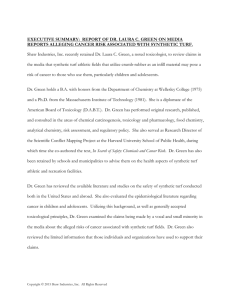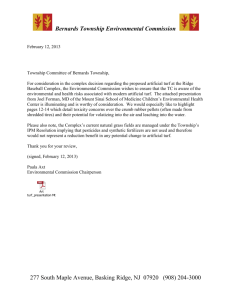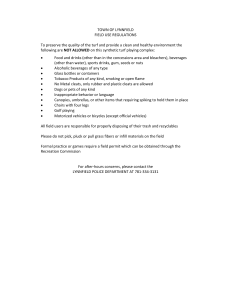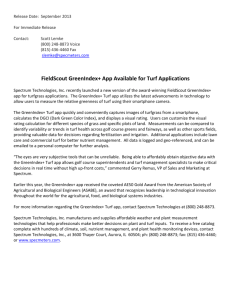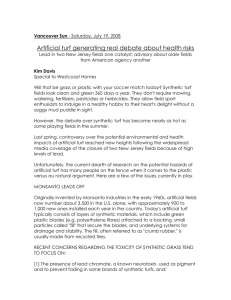Recreation and Parks Memo about new Synthetic Turf Purchasing
advertisement
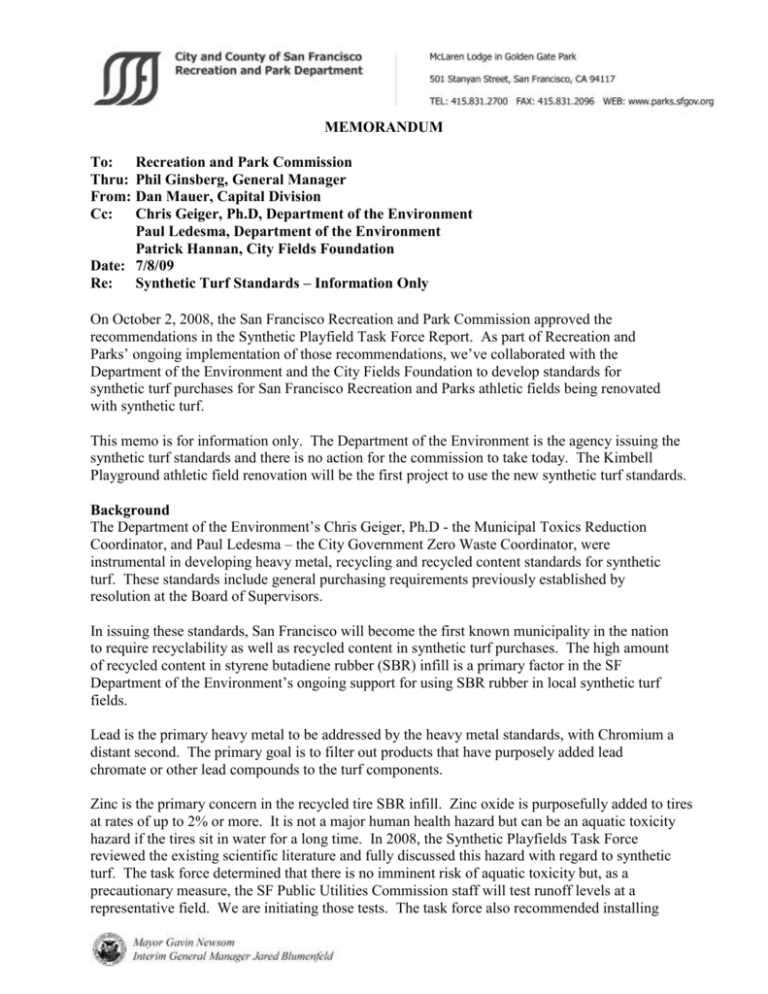
MEMORANDUM To: Recreation and Park Commission Thru: Phil Ginsberg, General Manager From: Dan Mauer, Capital Division Cc: Chris Geiger, Ph.D, Department of the Environment Paul Ledesma, Department of the Environment Patrick Hannan, City Fields Foundation Date: 7/8/09 Re: Synthetic Turf Standards – Information Only On October 2, 2008, the San Francisco Recreation and Park Commission approved the recommendations in the Synthetic Playfield Task Force Report. As part of Recreation and Parks’ ongoing implementation of those recommendations, we’ve collaborated with the Department of the Environment and the City Fields Foundation to develop standards for synthetic turf purchases for San Francisco Recreation and Parks athletic fields being renovated with synthetic turf. This memo is for information only. The Department of the Environment is the agency issuing the synthetic turf standards and there is no action for the commission to take today. The Kimbell Playground athletic field renovation will be the first project to use the new synthetic turf standards. Background The Department of the Environment’s Chris Geiger, Ph.D - the Municipal Toxics Reduction Coordinator, and Paul Ledesma – the City Government Zero Waste Coordinator, were instrumental in developing heavy metal, recycling and recycled content standards for synthetic turf. These standards include general purchasing requirements previously established by resolution at the Board of Supervisors. In issuing these standards, San Francisco will become the first known municipality in the nation to require recyclability as well as recycled content in synthetic turf purchases. The high amount of recycled content in styrene butadiene rubber (SBR) infill is a primary factor in the SF Department of the Environment’s ongoing support for using SBR rubber in local synthetic turf fields. Lead is the primary heavy metal to be addressed by the heavy metal standards, with Chromium a distant second. The primary goal is to filter out products that have purposely added lead chromate or other lead compounds to the turf components. Zinc is the primary concern in the recycled tire SBR infill. Zinc oxide is purposefully added to tires at rates of up to 2% or more. It is not a major human health hazard but can be an aquatic toxicity hazard if the tires sit in water for a long time. In 2008, the Synthetic Playfields Task Force reviewed the existing scientific literature and fully discussed this hazard with regard to synthetic turf. The task force determined that there is no imminent risk of aquatic toxicity but, as a precautionary measure, the SF Public Utilities Commission staff will test runoff levels at a representative field. We are initiating those tests. The task force also recommended installing synthetic turf fields above the water table and using a criteria based site selection process to determine the potential public health benefits of an installation. San Francisco Synthetic Turf Standards The synthetic turf standards fall into three general categories: end-of-life recycling plans, postconsumer recycled content and heavy metal and material content. Potential vendors will be required to provide the information when submitting project bids. Any bids with incomplete information or insufficient data will be rejected. End-of-Life Recycling Plans Potential vendors will be required to provide detailed plans for the management of all turf product components at the end of their useful life, including: a. Manner of reuse/recycling for each product component b. Identification of parties responsible for the removal and disposal of the field products. c. A description of the reuse or recycling process. d. A signed commitment from the winning proposal’s signatory guaranteeing implementation of the plan within seven (7) years of the contract ratification. e. These plans shall not include incineration, or any other type of high temperature conversion technology. f. These plans shall not include the use of synthetic turf as Alternate Daily Cover. g. Using the discarded synthetic turf in either of these methods may impact a firm's future opportunities for the contracting of synthetic turf fields. Post Consumer Recycled Content All synthetic turf purchased by San Francisco will include recycled content to the maximum extent feasible. a. Potential vendors will provide the amount and type of recycled content in the turf product. b. Proposals that do not include recycled content must provide an explanation as to why it was omitted and describe plans for inclusion of recycled content in the future. Heavy Metals and Material Content Potential vendors will conduct and submit product analysis with the project bid. Analysis will be presented in the form of certified laboratory results using specified standards and processes. Analytical Methodologies: Representative samples of the turf fibers, turf backing, and infill material shall be analyzed for total metals content and semi-volatile organic compounds (SVOCs), as well as select analyses for leachable metals concentrations. 1) Total Metals Analysis: All samples (fibers, infill, underlayment and backing) shall be analyzed for the California Assessment Manual 17/Title 26 list of metals (CAM 17 metals). The submitted samples shall be prepared by the laboratory for analysis of total recoverable metals by USEPA method 3050B. The samples shall then be analyzed for total metals concentrations by USEPA method 6010B/7400. 2) Leachable Metals Analysis: Infill samples only shall be analyzed for leachability of selected metals using the California Waste Extraction Test (WET). All samples shall be analyzed by the WET for lead, zinc, and total chromium. For other constituents, if the detected concentrations from the total metals analysis above are greater than or equal to ten times the Soluble Threshold Limit Concentration (STLC) value, as shown on attached Table B, the WET shall be conducted for those individual metals as well. 3) Analysis for SVOCs: All samples (fibers, infill, underlayment, backing.) shall be analyzed for the SW-846 list of SVOCs. The submitted samples shall be prepared by the laboratory for analysis by USEPA method 3540 or 3550. The samples shall then be analyzed for SVOC concentrations by USEPA method 8270B or 8270C. Results shall at a minimum include data for aniline (CAS #62-53-3), phenol (108-95-2) and benzothiazole (95-16-9). Concentrations of SVOCs are to be provided for reference purposes only and are not being evaluated against any particular criteria. Evaluation Criteria: The detected concentrations of lead, chromium, and zinc in the samples of the turf and the cushioning material shall not exceed the threshold values listed in Table A-C for total metals and leachable metals analyses. In no case shall the total metal concentration of any metal equal or exceed the TTLC values. In addition, concentrations of metals detected in any leachate tests shall not exceed the STLC value (for threshold values, see California Code of Regulations, Title 22, Chapter 11, Article 3.) Brominated flame retardants Vendor shall provide verification that brominated flame retardants have not been intentionally added in the manufacture of the turf fiber, backing, underlayment or infill materials. Verification can take the form of a signed letter from the manufacturer, or appropriate laboratory analyses of the product proving that levels of elemental bromine are lower than 1% by weight. TABLE A. Maximum levels of metals permitted for San Francisco synthetic turf products – recycled styrene butadiene rubber (SBR) infill materials Metal Total metals analysis Leachable metals analysis (mg/kg) (ug/L) Chromium 750i,ii 50i Lead 50 2.5i iii Zinc 23,000 250,000iv i. San Francisco Regional Water Quality Control Board (SFRWQCB) Environmental Screening Level (ESL) for residential land use for compounds detected in shallow soils where groundwater is a current or potential source of drinking water. See: http://www.swrcb.ca.gov/rwqcb2/esl.shtml ii. No total chromium value promulgated in ESLs; chromium III value indicated instead. iii. California Human Health Screening Levels (CHHSLs) for soil for residential land use. iv. Selected soluble threshold limit concentration (STLC). TABLE B. Maximum levels of metals permitted for San Francisco synthetic turf products – non-SBR infill materials Metal Chromium Lead Zinc Total metals analysis (mg/kg) 750i,ii 50 23,000iii Leachable metals analysis (ug/L) 50i 2.5i 81i i. San Francisco Regional Water Quality Control Board (SFRWQCB) Environmental Screening Level (ESL) for residential land use for compounds detected in shallow soils where groundwater is a current or potential source of drinking water. See: http://www.swrcb.ca.gov/rwqcb2/esl.shtml ii. No total chromium value promulgated in ESLs; chromium III value indicated instead. iii. California Human Health Screening Levels (CHHSLs) for soil for residential land use. TABLE C. Maximum levels of total metals permitted for San Francisco synthetic turf products – fibers, underlayment, and backing Metal Chromium Lead Total metals analysis (mg/kg) 25 50
